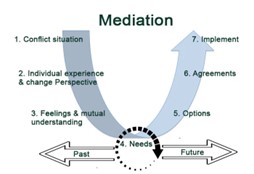What is Mediation?
Mediation includes many facets. It is not counseling, mentoring, or coaching. Here is a definition of Mediation:
Mediation is a process where people meet with a mutually, impartial, and a neutral person who helps them in the negotiation of their differences.
Culture:
As I have been working with different organizations, I realized that we all wear ‘cultural lenses’ and we tend to interpret different situations according to our cultural values. The West values openness, honesty and justice. It is important to find the truth or the right position in every situation. If wrong has been done, the guilty party must be sought out and justice must be done. In conflict resolution, the direct, confrontational and one-to-one approach is often used.
In the non-Western world, relationship, honor and group harmony are valued. A problem may be viewed as a communal affair. The individual may not be singled out or identified if this can help to preserve group harmony or individual honor. Great tact and gentleness would be exercised in order to salvage the ‘dignity’ of the person concerned. In these cultures, the worst thing a person can do is cause another to be shamed, lose face or be dishonored.
When I started in 1985 to do problem solving I did it through my cultural lenses and I unknowingly shamed, manipulated, and spiritual abused Co-Workers, because I was not equipped and did not have the proper training then. Two years later people like George Verwer and Peter Maiden took me under their wings and start mentoring me and allowed me to work on my stuff from the past. As I am a wounded healer, I can relate to all situations without taking side. This also plays a part in understanding culture and working on my own stuff on a regular basis: only through this process I can do mediation.
Model for Mediation:
How do I go about with my mediation? I use the following model:

1.Conflict Situation
We are not in heaven yet there will always be conflict on all levels. When I get a request that there is conflict situation:
I first talk to the people who requested me to be involved in the situation.
- A location should be allocated for the process which is not accessible to the rest of the staff.
- Talk to everybody involved in the conflict.
- Make notes of what each person has told you (I tell them that I make notes so I don’t forget. I read it back to them so that there are no miscommunications).
- I stress the whole issue of confidentiality.
- If I know everybody or some of the people that are involved in the process, I ask if it is ok if I do the mediation and to make sure that they know that I will be neutral.
- Time and place will be discussed.
- Who needs to be informed.
- I will set up a time for the first mediation.
- I also make it vey clear not to play the God card as the mediation is not about God.
- I will then set up a contract. Which they all must sign before we begin.
- There is also a contract set up with the person who contacted me.
This process will be different if the mediation is different groups or people from different countries or continents.
2. Individual experience and changing perspectives.
- It is important that everybody can express how they experienced the event without any interruption.
- I again make sure I understand what they are saying and put some key words on a flipchart.
- I cluster then all the words that have the similar meaning together.
- Then we decide which of the themes they want to discuss.
3. Feelings and mutual understanding
I was really struggling to explain this level because I actually had no words for it, so I googled it and this picture is a very good way to explain it.

At this stage I can either make it or break it. This is a crucial stage in the mediation process.
I cannot take it for granted that everybody is on the same communication level:

4. Needs
As I am dealing with so many people from different cultures and backgrounds, they all have different needs. As a mediator it is important to validate the needs of all. When the one side cannot understand or see the needs of the other then there is another whole process needed. For that process, this article format is too short.
5. Options
If we come to an understanding, then we all look at the different options and make sure that everybody understands them. This is especially important if there are different cultures and people whose first language is not English.
6. Agreements
Then I set up an agreement document. I give each one a copy and let them read through it. Then I read it slowly to everybody. They can stop me anytime if they do not understand what is written in the agreement. Then I let them sign the document.
I write a report to those who requested the mediation.
7. Implementation
I set up a meeting with all parties including those who asked me to do the mediation and then we work on a road map forward.
Unfortunately, it is important to say that not every mediation is successful, and sometimes other steps are needed. This is just a short introduction of how I would do mediation. I hope it has been helpful to you to get a better understanding of how mediation works.



